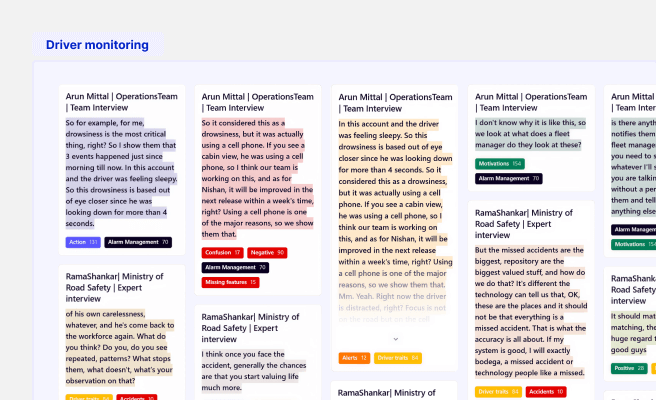Context of Use
<p>Context of use refers to understanding the environment or situations in which a product or service is used. This includes factors such as the physical environment, social settings, and the tasks the user aims to accomplish. Recognizing context of use is crucial for designing user-centric products that meet the real needs of users, especially in complex fields like climate tech.</p>
<p>For example, in the climate tech industry, the context of use for a carbon capture system may include harsh environmental conditions, regulatory compliance requirements, and the need for user-friendly interfaces for monitoring and maintenance. Understanding these factors can significantly improve the product's design and usability.</p>
<h2 id="2">Importance of Context of Use</h2>
<p>Understanding the context of use helps designers create solutions that are not only effective but also intuitive for the end-users. It allows for the development of products that are aligned with user expectations and real-world conditions. This is particularly important for visionary founders in climate tech, who aim to build credibility and communicate their organization’s impact effectively.</p>
<p>By considering the context of use, companies can reduce operational bandwidth and make it easier for their teams to adopt and utilize new technologies. This is especially beneficial for organizations with limited ability to hire full-time employees for specific, high-value work.</p>
<h3 id="3">Elements of Context of Use</h3>
<p>Several elements contribute to understanding the context of use:</p>
<ul>
<li><strong>Physical Environment:</strong> Includes factors like location, weather conditions, and available infrastructure.</li>
<li><strong>Social Settings:</strong> Involves the interactions between users, stakeholders, and other relevant parties.</li>
<li><strong>Tasks and Goals:</strong> Focuses on what users aim to accomplish and the steps they take to achieve these goals.</li>
<li><strong>Tools and Devices:</strong> Considers the hardware and software tools that users employ to complete their tasks.</li>
</ul>
<h3 id="4">Real-world Examples</h3>
<p>A practical example can be seen in the design of mobile applications for climate monitoring. These apps need to function seamlessly in various environments, such as rural areas with limited internet connectivity or urban settings with high pollution levels. By understanding these contexts, designers can create features that are resilient and user-friendly.</p>
<p>Another example is the use of <a href="https://www.invisionapp.com/" style="color:#2896FF; text-decoration: underline;">InVision</a> for prototyping in real-world scenarios. By using tools like InVision, designers can test their products in different contexts to gather feedback and make necessary adjustments.</p>
<h2 id="5">Implementing Context of Use in Design</h2>
<p>To effectively implement context of use in design, companies can follow these steps:</p>
<ol>
<li><strong>User Research:</strong> Conduct thorough research to understand the users' environment, behaviors, and challenges.</li>
<li><strong>Field Studies:</strong> Observe users in their natural settings to gain insights into their interactions with the product.</li>
<li><strong>Prototyping:</strong> Create prototypes to test the product in different contexts and gather user feedback.</li>
<li><strong>Iterative Design:</strong> Use the feedback to make iterative improvements to the product.</li>
</ol>
<p>For instance, a design team working on a new agricultural technology can perform field studies on farms to observe the use of their product under various weather conditions and operational scenarios. This helps in making informed design decisions that lead to more robust and user-friendly solutions.</p>
<h3 id="6">Challenges in Understanding Context of Use</h3>
<p>One of the main challenges is the variability in user environments. For example, a product designed for urban settings may not perform well in remote areas with limited resources. Additionally, gathering accurate data on user behavior in different contexts can be resource-intensive and time-consuming.</p>
<p>Another challenge is aligning the product design with regulatory requirements, especially in specialized fields such as climate tech. Designers need to ensure that their products comply with relevant standards and guidelines while still meeting user needs.</p>
<h3 id="7">Overcoming Challenges</h3>
<p>To overcome these challenges, companies can use a combination of qualitative and quantitative research methods. User interviews, surveys, and field observations can provide a comprehensive understanding of the context of use. Additionally, leveraging tools like <a href="https://www.usertesting.com/" style="color:#2896FF; text-decoration: underline;">UserTesting</a> can help gather valuable user feedback and insights.</p>
<h2 id="8">Conclusion</h2>
<p>Understanding the context of use is essential for designing user-centric products that meet real-world needs. It helps in creating solutions that are intuitive, effective, and aligned with user expectations. By incorporating elements like physical environment, social settings, tasks, and tools, designers can create products that truly resonate with their audience.</p>
<p>For visionary founders in climate tech, focusing on context of use can help build credibility, communicate impact effectively, and reduce operational bandwidth. By adopting a comprehensive approach to understanding user contexts, companies can create innovative and sustainable products that drive success in the competitive climate tech landscape.</p> <p>We’re using the power of design to increase the adoption of climate technologies and innovation. View our work in climate to know more on how we can support your vision. <a href="https://www.whatifdesign.co/climate" style="color:#2896FF; text-decoration:underline;">View our climate projects</a>.</p> <p>Increase user engagement that converts your demos into sales. Optimise your UX strategies with our audits.
<p>Fill out the <a href="https://tally.so/r/n97pxQ" style="color:#2896FF; text-decoration:underline;">UX Audit form</a> to get started. Ready to discuss your needs? <a href="https://cal.com/akhilak/what-if-design?duration=25" style="color:#2896FF; text-decoration:underline;">Book a consultation call</a> with us today.</p></p>

Let's scale your impact with great design.
Free consultation, no sales pitch
Thank you! Your submission has been received!
Oops! Something went wrong while submitting the form.
Let’s talk
Nothing great is built alone.
Let’s connect about your vision, our work and how we can collaborate.
Get in touch

